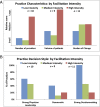Practice-tailored facilitation to improve pediatric preventive care delivery: a randomized trial
- PMID: 24799539
- PMCID: PMC4035588
- DOI: 10.1542/peds.2013-1578
Practice-tailored facilitation to improve pediatric preventive care delivery: a randomized trial
Abstract
Objective: Evolving primary care models require methods to help practices achieve quality standards. This study assessed the effectiveness of a Practice-Tailored Facilitation Intervention for improving delivery of 3 pediatric preventive services.
Methods: In this cluster-randomized trial, a practice facilitator implemented practice-tailored rapid-cycle feedback/change strategies for improving obesity screening/counseling, lead screening, and dental fluoride varnish application. Thirty practices were randomized to Early or Late Intervention, and outcomes assessed for 16 419 well-child visits. A multidisciplinary team characterized facilitation processes by using comparative case study methods.
Results: Baseline performance was as follows: for Obesity: 3.5% successful performance in Early and 6.3% in Late practices, P = .74; Lead: 62.2% and 77.8% success, respectively, P = .11; and Fluoride: <0.1% success for all practices. Four months after randomization, performance rose in Early practices, to 82.8% for Obesity, 86.3% for Lead, and 89.1% for Fluoride, all P < .001 for improvement compared with Late practices' control time. During the full 6-month intervention, care improved versus baseline in all practices, for Obesity for Early practices to 86.5%, and for Late practices 88.9%; for Lead for Early practices to 87.5% and Late practices 94.5%; and for Fluoride, for Early practices to 78.9% and Late practices 81.9%, all P < .001 compared with baseline. Improvements were sustained 2 months after intervention. Successful facilitation involved multidisciplinary support, rapid-cycle problem solving feedback, and ongoing relationship-building, allowing individualizing facilitation approach and intensity based on 3 levels of practice need.
Conclusions: Practice-tailored Facilitation Intervention can lead to substantial, simultaneous, and sustained improvements in 3 domains, and holds promise as a broad-based method to advance pediatric preventive care.
Trial registration: ClinicalTrials.gov NCT01739166.
Keywords: child; dental caries; lead poisoning; obesity; quality improvement.
Copyright © 2014 by the American Academy of Pediatrics.
Figures






Similar articles
-
From concept to application: the impact of a community-wide intervention to improve the delivery of preventive services to children.Pediatrics. 2001 Sep;108(3):E42. doi: 10.1542/peds.108.3.e42. Pediatrics. 2001. PMID: 11533360 Clinical Trial.
-
Practice based education to improve delivery systems for prevention in primary care: randomised trial.BMJ. 2004 Feb 14;328(7436):388. doi: 10.1136/bmj.38009.706319.47. Epub 2004 Feb 6. BMJ. 2004. PMID: 14766718 Free PMC article. Clinical Trial.
-
Improving prevention in primary care: Evaluating the sustainability of outreach facilitation.Can Fam Physician. 2008 May;54(5):712-20. Can Fam Physician. 2008. PMID: 18474705 Free PMC article.
-
Cost-Benefit Analysis of Providing Fluoride Varnish in a Pediatric Primary Care Office.J Pediatr Health Care. 2018 Nov-Dec;32(6):620-626. doi: 10.1016/j.pedhc.2018.05.007. J Pediatr Health Care. 2018. PMID: 30368308 Review.
-
The Public Health Reach of High Fluoride Vehicles: Examples of Innovative Approaches.Caries Res. 2016;50 Suppl 1:61-7. doi: 10.1159/000443186. Epub 2016 Apr 22. Caries Res. 2016. PMID: 27099929 Review.
Cited by
-
Remote coaching for supporting the implementation of treatment for depression in primary care in Madhya Pradesh, India: protocol for a cluster randomized controlled trial.Front Health Serv. 2024 Sep 24;4:1477444. doi: 10.3389/frhs.2024.1477444. eCollection 2024. Front Health Serv. 2024. PMID: 39381591 Free PMC article.
-
Accelerating Improvement in Children's Healthcare Through Quality Improvement Collaboratives: A Synthesis of Recent Efforts.Curr Treat Options Pediatr. 2019 Jun;5(2):111-130. doi: 10.1007/s40746-019-00155-6. Epub 2019 May 4. Curr Treat Options Pediatr. 2019. PMID: 32789105 Free PMC article.
-
Effectiveness of Quality Improvement Coaching on Process Outcomes in Health Care Settings: A Systematic Review.J Gen Intern Med. 2022 Mar;37(4):885-899. doi: 10.1007/s11606-021-07217-2. Epub 2022 Jan 3. J Gen Intern Med. 2022. PMID: 34981354 Free PMC article.
-
Rationale and design for Healthy Hearts in Manufacturing (HHM): A pragmatic single-arm hybrid effectiveness-implementation study for hypertension management and tobacco cessation.Contemp Clin Trials Commun. 2025 Feb 3;44:101444. doi: 10.1016/j.conctc.2025.101444. eCollection 2025 Apr. Contemp Clin Trials Commun. 2025. PMID: 40008276 Free PMC article.
-
Does coaching matter? Examining the impact of specific practice facilitation strategies on implementation of quality improvement interventions in the Healthy Hearts in the Heartland study.Implement Sci. 2021 Mar 31;16(1):33. doi: 10.1186/s13012-021-01100-8. Implement Sci. 2021. PMID: 33789696 Free PMC article.
References
-
- American Academy of Pediatrics. Recommendations for Preventive Pediatric Health Care. 2008. Available at: http://brightfutures.aap.org/pdfs/aap bright futures periodicity sched 1.... Accessed January 7, 2013
-
- McGlynn EA, Damberg, CL, Kerr, EA, Schuster, MA. Quality of care for children and adolescents: a review of selected clinical conditions and quality indicators. 2000. Rand Corporation. Available at: www.rand.org/pubs/monograph_reports/MR1283.html. Accessed January 7, 2013
-
- Advisory Committee on Immunization Practices, Temte, JL, Chair. Centers for Disease Control and Prevention. Recommended immunization schedule for persons aged 0 through 6 years–United States, 2012. 2012. Available at: http://aapredbook.aappublications.org/site/resources/IZSchedule0-6yrs.pdf. Accessed January 7, 2013
-
- Mangione-Smith R, DeCristofaro AH, Setodji CM, et al. . The quality of ambulatory care delivered to children in the United States. N Engl J Med. 2007;357(15):1515–1523 - PubMed
Publication types
MeSH terms
Substances
Associated data
Grants and funding
LinkOut - more resources
Full Text Sources
Other Literature Sources
Medical

